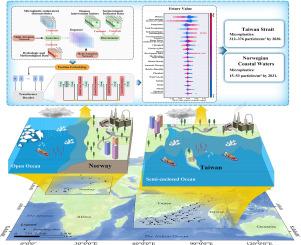数据稀缺下未来海洋微塑料分布的多场景模拟:深度学习方法
IF 12.4
1区 环境科学与生态学
Q1 ENGINEERING, ENVIRONMENTAL
引用次数: 0
摘要
评估海洋微塑料(MP)丰度的未来趋势是减轻MP污染的关键一步。然而,这一任务受到观测数据的缺乏和MPs在多种相互作用因素驱动下的明显时空异质性的挑战。在本研究中,我们介绍了CGMAT,这是一种新型的深度学习框架,它将Few-Shot学习(FSL)与基于transformer的架构集成在一起。CGMAT增强了来自台湾海峡和挪威沿海水域的异构数据集,以确定MPs污染的关键驱动因素,并预测未来MPs的时空分布。多场景仿真表明,CGMAT在源域验证数据上取得了优异的性能(解释方差得分(ev) = 0.91,平均绝对百分比误差(MAPE) = 0.18%)。尽管如此,预测结果显示了显著的区域差异的空气污染趋势。具体而言,预计台湾海峡的MP浓度将急剧增加,在2030年左右达到312-376颗粒/m³,而挪威沿海水域的浓度预计将逐渐上升,在2031年左右达到15-53颗粒/m³的峰值。在达到峰值之后,预计污染水平将在环境动态和缓解措施的综合影响下趋于稳定。CGMAT的多尺度特征融合架构进一步揭示了生态环境的时空动态是由经济干预强度、滞后环境响应和地理障碍三种主要机制共同作用的结果。这些发现强调了将FSL与基于transformer的DL模型相结合的巨大潜力,以解决数据稀缺的挑战,并为不同的海洋生态系统提供广泛适用的框架。本文章由计算机程序翻译,如有差异,请以英文原文为准。

Multi-scenario simulation of future marine microplastic distribution under data scarcity: A deep learning approach
Assessing future trends in marine microplastic (MP) abundance is a crucial step toward mitigating MP pollution. However, this task is challenged by the scarcity of observational data and the pronounced spatiotemporal heterogeneity of MPs driven by multiple interacting factors. In this study, we introduce CGMAT, a novel deep learning (DL) framework that integrates Few-Shot Learning (FSL) with a Transformer-based architecture. CGMAT enhances heterogeneous datasets from the Taiwan Strait and the Norwegian coastal waters to identify key drivers of MP pollution and to predict the future spatiotemporal distribution of MPs. Multi-scenario simulations demonstrate that Cross-domain Multi-Graph Attention Network (CGMAT) framework achieves excellent performance on the source domain validation data (explained variance score (EVS) = 0.91, mean absolute percentage error (MAPE) = 0.18 %). Nevertheless, forecast results reveal significant regional variations in MP pollution trends. Specifically, MP concentrations in the Taiwan Strait are projected to increase sharply, reaching 312–376 particles/m³ around 2030, whereas concentrations along the Norwegian coast waters are expected to rise more gradually, peaking at 15–53 particles/m³ around 2031. Following the peak, pollution levels are anticipated to stabilize under the combined influence of environmental dynamics and mitigation measures. The multi-scale feature fusion architecture of CGMAT further reveals that the spatiotemporal dynamics of MP distribution are governed by the interplay of three principal mechanisms: the intensity of economic interventions, delayed environmental responses, and geographical barriers. These findings highlight the significant potential of combining FSL with Transformer-based DL models to address data scarcity challenges and provide a broadly applicable framework for different marine ecosystems.
求助全文
通过发布文献求助,成功后即可免费获取论文全文。
去求助
来源期刊

Water Research
环境科学-工程:环境
CiteScore
20.80
自引率
9.40%
发文量
1307
审稿时长
38 days
期刊介绍:
Water Research, along with its open access companion journal Water Research X, serves as a platform for publishing original research papers covering various aspects of the science and technology related to the anthropogenic water cycle, water quality, and its management worldwide. The audience targeted by the journal comprises biologists, chemical engineers, chemists, civil engineers, environmental engineers, limnologists, and microbiologists. The scope of the journal include:
•Treatment processes for water and wastewaters (municipal, agricultural, industrial, and on-site treatment), including resource recovery and residuals management;
•Urban hydrology including sewer systems, stormwater management, and green infrastructure;
•Drinking water treatment and distribution;
•Potable and non-potable water reuse;
•Sanitation, public health, and risk assessment;
•Anaerobic digestion, solid and hazardous waste management, including source characterization and the effects and control of leachates and gaseous emissions;
•Contaminants (chemical, microbial, anthropogenic particles such as nanoparticles or microplastics) and related water quality sensing, monitoring, fate, and assessment;
•Anthropogenic impacts on inland, tidal, coastal and urban waters, focusing on surface and ground waters, and point and non-point sources of pollution;
•Environmental restoration, linked to surface water, groundwater and groundwater remediation;
•Analysis of the interfaces between sediments and water, and between water and atmosphere, focusing specifically on anthropogenic impacts;
•Mathematical modelling, systems analysis, machine learning, and beneficial use of big data related to the anthropogenic water cycle;
•Socio-economic, policy, and regulations studies.
 求助内容:
求助内容: 应助结果提醒方式:
应助结果提醒方式:


